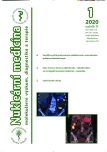Specific features of use of a positron radiopharmaceutical in the automatic infusion system Medrad Intego
Authors:
Martin Havel 1,2; Michal Koláček 1,2; Kateřina Häringová 1; Otakar Kraft 1,2; Michaela Vávrová 1; Kamil Bukovanský 1; Gabriela Havlová 1
Authors‘ workplace:
Klinika nukleární medicíny, Fakultní nemocnice Ostrava, 2 Lékařská fakulta, Ostravská univerzita, ČR
1
Published in:
NuklMed 2020;9:2-9
Category:
Original Article
Overview
Introduction: Automatic positron radiopharmaceutical infusi - on systems are becoming a common part of PET departments. The aim of this work is to analyze the optimal number of examined patients from one batch of 18F-FDG in the Medrad Intego automatic infusion system and to evaluate possible factors influencing the efficiency of radiopharmaceutical utility.
Material and methods: The automatic infusion system has certain technical properties and associated limitations concerning the work with radiopharmaceuticals. We created situational models of examination plans for 1 to 14 patients and looked for the model with the lowest average processed activity per examination, considering several application schedules and specific activities of the radiopharmaceutical (2–3.5 MBq/kg, application intervals 20–35 minutes, specific activities of radio - pharmaceutical 750, 1000 and 1250 MBq/ml). We also modeled these schemes for a plan of 8 patients under investigation, looking for the scheme with the lowest activity consumed versus the activity actually administered and the dependencies associated with the specific activity of the radiopharmaceutical. The modeling was calculated using the MS Excel Solver extension.
Results: The number of examinations with the minimum average activity per one administration was dependent on the selected scheme, but also on the specific activity of the radiopharmaceutical. For specific activity of 750 MBq/ml, this number ranged from 4 to 7 patients; for specific activity of 1000 and 1250 MBq/ml number was in range from 5 and 8 patients. In the modeling plan of the 8 examination, the difference in activity required and actually administered ranged from 1648.6 to 4104.7 MBq for specific activity of 750 MBq/ml, for specific activity of 1000 MBq/ml from 1933.6 to 4389.7 MBq, for a specific activity of 1250 MBq/ml from 2218.6 to 4674.7 MBq. We confirmed the linear dependence of the required activity to meet the plan on the specific activity of the supplied radiopharmaceutical.
Conclusion: When considering the economic aspects of using an automatic infusion system, it is necessary to consider the total cost of operating the department. One important parameter that contributes to the actual consumption of a radiopharmaceutical in the Medrad Intego system is the specific activity of the radiopharmaceutical.
Keywords:
infusion system Medrad Intego – Economic analysis
Sources
-
Bayer Vital GmbH Deutschland Radiology Leverkusen. Medrad Intego PET Infusion System [online]. [cit. 2020-02-15]. Dostupné na: https://www.radiologie.bayer.de/pet-angio/pet-intego
-
Matteucci F, Solinas L, Turri V, et al. IntegoTM Infusion System: cost effectiveness analysis focusing on dosimetry, sterility and management. Q J Nucl Med Mol Imaging. 2016;63 : 183-190 doi:10.23736/S1824-4785.16.02866-1
-
Depken CA. Mikroekonomie Bez Předchozích Znalostí. 1. vyd. Brno: BizBooks; 2013, 296 p
-
Jurečka V. Mikroekonomie. 3., aktual. Praha: Grada Publishing; 2018, 400 p
-
Havel M. Ekonomická analýza dostupných způsobů přípravy a aplikace radiofarmaka - závěrečná práce modulu Aplikovaná manažerská ekonomie, MBA, Ekonomická fakulta, Vysoká škola báňská – Technická univerzita Ostrava. 2019
-
Schleipman AR, Gerbaudo VH. Occupational Radiation Dosimetry Assessment Using an Automated Infusion Device for Positron-Emitting Radiotracers. J Nucl Med Technol . 2012;40 : 244-248 doi:10.2967/jnmt.112.106070
-
Talbot F, Mountz J, Coates L. Observed dose accuracy using Medrad Intego PET Infusion System. J Nucl Med. 2009;50(supplement 2):2030 [online]. [cit. 2020-02-15]. Dostupné na: http://jnm.snmjournals.org/content/50/supplement_2/2030.abstract.
-
Krumrey S, Frye R, Tran I, et al. FDG manual injection verses infusion system: A comparison of dose precision and extravasation. J Nucl Med. 009;50(supplement 2):2031 [online]. [cit. 2020-02-15]. Dostupné na: http://jnm.snmjournals.org/con-tent/50/supplement_2/2031.abstract.
-
Kohutova R, Havel M, Jirik V, et al. Optimalizace ochrany zdravotnickych pracovniku pri praci s otevrenymi zdroji ionizujiciho zareni na PET/CT ve FN Ostrava. Hygiena. 2019;64 : 96-104 [online]. [cit. 2020-02-15]. Dostupné na: https://hygiena.szu.cz/cz/artkey/hyg-201903-0002.php.
Labels
Nuclear medicine Radiodiagnostics RadiotherapyArticle was published in
Nuclear Medicine

2020 Issue 1
Most read in this issue
- Situs viscerum inversus abdominalis – náhodný nález při scintigrafii značenými leukocyty – kazuistika
- Specific features of use of a positron radiopharmaceutical in the automatic infusion system Medrad Intego
- Renal cyst mimicking metastasis on a bone scan – advantage of a hybrid imaging
